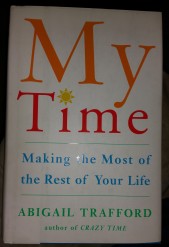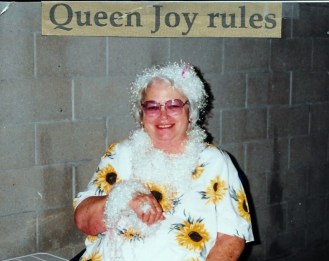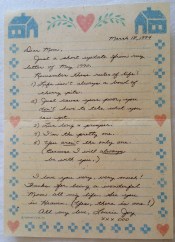Last September when I was diagnosed with breast cancer, I posted an essay in this space about a vivid dream with an important message from my mother. I condensed her rather eloquent advice into something akin to a pop culture metaphor.
“I should have a few less columns on my spreadsheets.”
For those not schooled in the addictive powers of Microsoft Excel, the basic translation is that I should dial down my natural tendency to over-analyze everything. Appropriately, the software reference is also reminiscent of my mother’s characterization of me as “queen of the spreadsheet.” It’s a moniker earned by my penchant for using Excel as a tool to create order out of the inevitable chaos that is life. I had to laugh when, looking

The Spreadsheet Queen
through pictures for something to post with this column, I ran across a 2008 photo in my mother’s files of … you guessed it … me working on a spreadsheet. That one was a budget for a family wedding.
In the first few weeks following my cancer diagnosis, I clung to my mother’s posthumous wisdom like a mantra. I didn’t want to research traditional treatments vs. alternate treatments or weigh my options against prognosis charts. I didn’t want to write pro and con lists or forecast outcomes using elaborate software formulas that resemble physics equations. I just wanted to do what my doctors recommended and pray for strength and grace. And I did.
I’m not sorry I took that stance. It was a good approach for someone whose emotions were raw and whose brain was on overload. It got me through the initial shock and the surgery.
However, once I felt more like myself again, I couldn’t suppress my own nature. In fact, I came close to being a complete failure at that resolution. It doesn’t really surprise me. I spent most of my public service career planning, developing, implementing and evaluating programs, and I’ve spent my most satisfying personal hours digging into topics that interest me and writing stories. Why should this experience generate a lesser response?
My first project was to research traditional treatment for Stage 1 Invasive Ductal Carcinoma. What I learned led to a couple of tough decisions. With my family’s blessing, I was prepared to reject chemotherapy if recommended. It was not. I was also prepared to reject radiation, which was pushed in a rather uncompromising fashion by a stern cancer radiologist who I’ve come to remember as Dr. Humorless. She wasn’t the reason I rejected radiation, but her demeanor certainly didn’t help sell me on her service. The one traditional treatment my research did convince me to accept is a hormone suppressant since my brand of cancer thrives on estrogen. I may not want to try to kill the beast by radiating every good cell around a few bad ones, but I don’t want to feed it either.
With those decisions made, but still no spreadsheets on my laptop, I turned my attention to reducing the risk of recurrence through nutrition. In the seven weeks since my retirement, I’ve read dozens of articles, watched multiple videos, and referenced some highly rated books on this broad subject. The volume of information is staggering. Unfortunately, some of it is also contradictory or suspect.
Take sugar for example. One claim, backed up by legitimate scientific studies, says sugar encourages cancer cells to grow. When I read that a few weeks ago, I was so shocked that my first impulse was to try to cut sugar out of my diet and write about it in this column. Since then, I’ve found reliable sources – like the Mayo Clinic and the MD Cancer Center – that don’t consider sugar consumption a bonafide risk.
In the end, I decided to trust my oncologist. She says, yes, if you inject pure sugar into the tumor of a lab mouse, the tumor will grow significantly. In real life, for humans, you would have to eat massive amounts of sugar to create the same effect. Instead, she regards sugar as a contributor to obesity, which is a known cancer risk. It’s not necessary to give it up entirely, she says, but Americans in general should eat much, much less. Naturally occurring sugar is not harmful; it’s the added sugars in processed foods that are ubiquitous and risky.
I’ve also read with interest about so-called super foods that combat cancer. There is truth to claims that apples, broccoli, cauliflower, tomatoes and other fruits and vegetables contain nutrients that help prevent or inhibit cancer growth. There is also truth to studies that show the primary benefit of consuming these foods is not to fight cancer, per se, but to promote overall wellness. Cancer, heart disease, diabetes and many other maladies have a tougher time taking control of a healthy body.
Some experts point out that, like sugar, we would have to eat massive quantities of a particular super food to truly make it singly effective against cancer. That’s not to say we shouldn’t consume them. Quite the opposite, in fact. I added pomegranate seeds and Brazil nuts to my shopping list after reading about their potential cancer benefits, but not to the exclusion of many other healthy foods that will help me trim down, bolster my immune system, lower my blood pressure, and generally feel good.
As I’ve educated myself about sugar, super foods and other nutrition strategies, I’ve simultaneously become very wary of the plethora of videos and articles posted on the Internet by people who introduce themselves as doctors but are actually clever entrepreneurs. All I will recommend, if you are inclined to click on something like “the five foods you should never eat,” is to further research any claims these people make. Almost without exception, they want to sell you something. The Internet is littered with predators out to make a buck.
Inevitably, I suppose, a couple of weeks ago I began to toy with the notion of entering all of my most reliable findings into a spreadsheet to try to isolate the best ways to approach nutrition as a cancer survivor. I could almost hear the sound of a needle scratching across a vinyl record when that idea came to an abrupt halt. It was the moment I noticed that two resources I trusted had completely opposite viewpoints on coffee and caffeine consumption. One recommended restricting caffeine to no more than 50 milligrams per day from coffee or any other source. The other said that caffeinated coffee consumption in normal amounts for Americans (e.g., up to 400 milligrams or four cups per day) is not a concern as long as every cup isn’t loaded with creamer. In fact, the latter resource said, some research indicates coffee consumption might actually be beneficial for cancer patients.
As soon as I saw those completely different schools of thought from two trusted resources, I knew I was done. I suddenly and vividly remembered my dear mother nodding when I said in my dream,
“You mean I should have a few less columns on my spreadsheets?”
This doesn’t mean I will never read another word about nutrition and cancer. What it means is that I’m going to implement the big takeaways from the research I’ve done and otherwise go on with my life. Quite honestly, I have better things to do with whatever time God grants me than obsess about everything I eat. It’s become a source of stress and, guess what, that is also a known cancer risk.
The big takeaways, if you are interested, are what we’ve been told by many respected nutritionists for many years. I don’t claim to be a subject matter expert myself, but it’s hard to argue these points.
- Eat a variety of fresh fruit and vegetables, whole grains, lean meats, legumes, nuts and fish. Go heavy on the fruits and vegetables and light on everything else.
- Use healthy fats like olive oil and coconut oil in your recipes.
- Stop eating food that isn’t real food. At the top of my personal list are margarine and artificial sweeteners. By definition, margarine is “imitation butter” and an artificial sweetener is a “synthetic sugar substitute.” Imitation and synthetic have no place in a healthy diet. Based on my research, I’m striving to stick with organic butter and sweeteners like raw honey, raw stevia leaves and dark amber maple syrup (formerly known as Grade B). The closer a food is to the way nature produced it, the better.
- Don’t try to lower your caloric intake by choosing reduced fat foods. What the manufacturers do to these foods to make them taste good with less fat is simply not healthy. Look it up or take my word for it; it’s better to just eat less of the real thing.
- Limit processed foods, which typically contain large amounts of sodium and added sugar. Your sodium and sugar intake should mostly be from the naturally occurring nutrients in the original food.
- Avoid foods that include preservatives and chemicals you can’t pronounce. The only things on the ingredient list should be real foods whose names you recognize.
- Buy certified organic foods. Stop eating pesticides, antibiotics and any food that has been genetically modified.
- If you need to lose weight, exercise portion control and get your body moving. Don’t rely on diet foods or diet aids.

Mom and me shortly after my birth in March 1954.
These are my big takeaways. And I don’t need a spreadsheet to convince me that they are sensible takeaways. If I happen to run across anything else that seems equally sensible, I’ll share it. Otherwise, I’m satisfied with my analysis. I’m not going to over-think this.
If I’ve learned anything from my brush with cancer, it’s that our days are not promised. Time is too precious to spend it doing anything that doesn’t give you joy. It’s not lost on me that my mother gave me her first name as my middle name. It’s a daily reminder of what she always wanted for me. JOY. Thank you, Mom. Message received.
 Mom flew off to “infinity and beyond” six years ago this month. Truth be told, it was rather a rude time for her to leave because it was just after Thanksgiving and her birthday and just before Christmas.
Mom flew off to “infinity and beyond” six years ago this month. Truth be told, it was rather a rude time for her to leave because it was just after Thanksgiving and her birthday and just before Christmas.



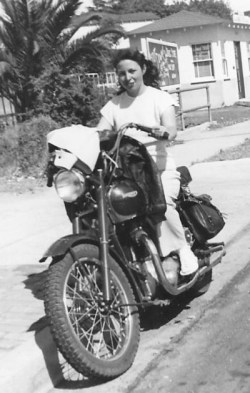
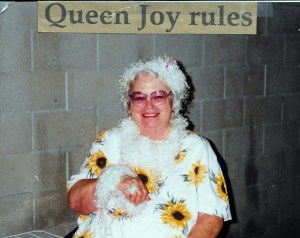




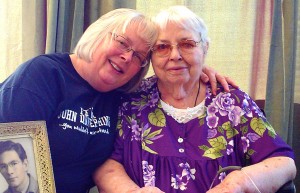
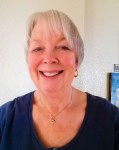 I thank the good Lord that Mom never had to deal with cancer on top of everything else that plagued her. She was certainly a prime candidate for it, just as I was. Hopefully, I learned about the risks of fat and sugar in time to save myself further health issues in my retirement years. Time will tell. For motivation, I’m going to make a little sign and tape it to my bathroom mirror. Thanks, Mom, for the quote.
I thank the good Lord that Mom never had to deal with cancer on top of everything else that plagued her. She was certainly a prime candidate for it, just as I was. Hopefully, I learned about the risks of fat and sugar in time to save myself further health issues in my retirement years. Time will tell. For motivation, I’m going to make a little sign and tape it to my bathroom mirror. Thanks, Mom, for the quote.



